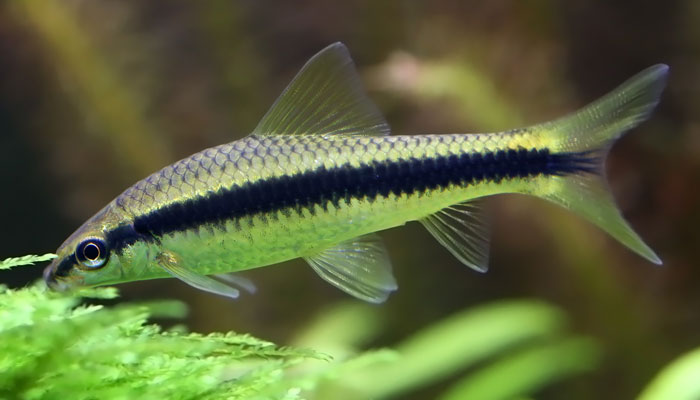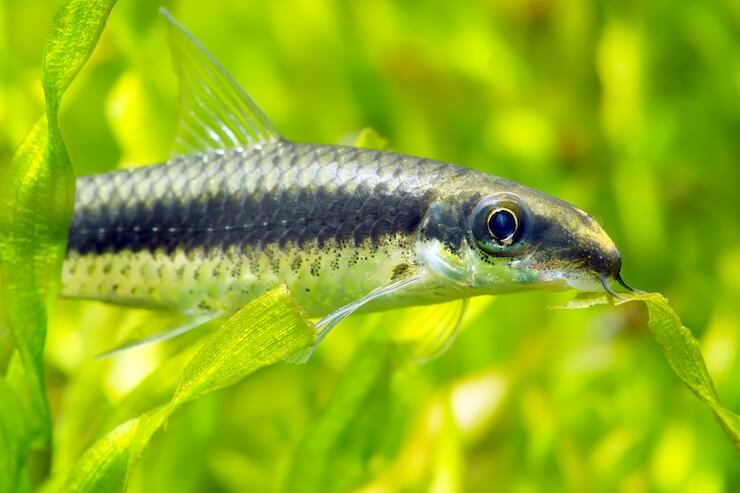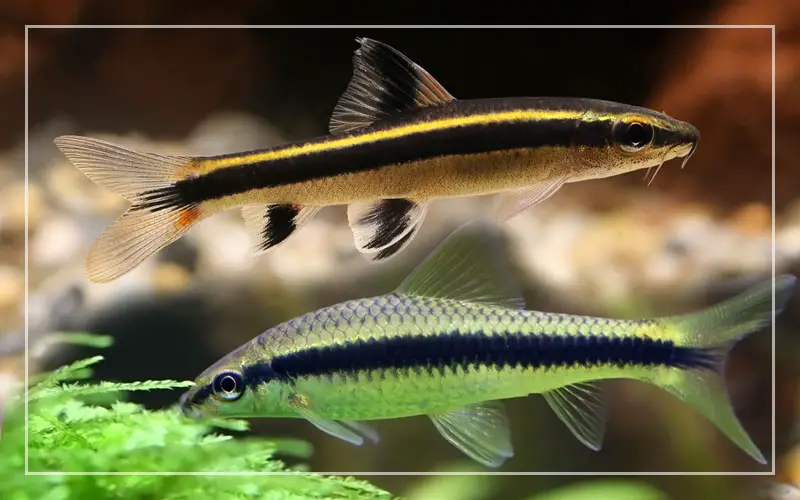Choosing the right algae-eating fish for your aquarium can be a daunting task, given the variety of options available.
Siamese algae eaters, on the other hand, could be just what you need if you’re just starting out as a fish keeper and you’re having trouble with an excessive amount of algae development in your tank. These fish are well-known for their extraordinary ability to keep the growth of algae under control, which makes them a perfect addition to a home aquarium.
Siamese algae eaters are well-known for their ability to consume algae and their peaceful and friendly attitude.
Because of their calm temperament, these fish are an excellent option for those who are just starting out in the hobby of keeping fish or for anybody else who prioritizes simplicity.
Siamese algae eaters are simple to care for and get along well with other fish species, which makes them a good choice for keeping in a community tank or putting into a separate aquarium to live on their own.
Siamese Algae Eater Species Overview

The Siamese algae eater is a freshwater fish species found in the rivers and lakes of Thailand and Cambodia. They are closely related to carp and minnows, as all three species are members of the family Cyprinidae. Because of their capacity to keep algae development in freshwater tanks under control, these fish are quite popular among enthusiasts who keep aquariums.
Benefits of Adding Siamese Algae Eaters to Your Tank
The addition of Siamese Algae Eaters to your aquarium has the potential to provide several benefits, including the following:
- Calm attitude: Siamese algae eaters have a calm temperament and are often friendly with other kinds of fish due to their peaceful nature. They are not hostile, and they do not often exhibit behavior associated with territoriality.
- Controlling algae effectively: Siamese Algae Eaters are exceptionally good at controlling various algae, including string algae and hair algae, amongst other types. They are known to consume significant quantities of algae, which contributes to maintaining a clean and healthy environment in your tank.
- Minimal maintenance: Siamese Algae Eaters are fish that require little to no maintenance and don’t need any particular attention or treatment. They are able to flourish in a wide variety of tank settings and may be readily fed a wide variety of items intended for other fish.
- Interesting behavior: Watching Siamese Algae Eaters swim about is fun since they have such exciting behavior. They have been seen swimming in schools and can exhibit various fascinating social activities.
- Hardy species: Siamese Algae Eaters are resilient fish species that can endure various water conditions and are considered to be a “hardy” species. In addition to this, they are immune to the majority of fish infections.
What Do They Look Like?

The Siamese Algae Eater is a long and narrow fish, like a torpedo, and it may reach a maximum length of 6 inches. They have a silver body with vertical black stripes that go from their head to their tails. The width of the stripes as well as the number of them might change based on the particular fish. They are able to attach themselves to the walls of the tank using their mouths, which are shaped like suction cups, so that they may scrape algae off the walls and ingest it.
General Behavior and Disposition
Siamese Algae Eaters are sociable fish that do not bother other species and prefer to swim in schools of at least three individuals. Because of this trait, they do not behave aggressively and can be housed in the same tank as other non-aggressive species. Because of their superior ability to consume hair algae and green spot algae, these fish are in high demand in the aquarium hobby.
Physical Appearance and Mistaken Identities
There is a chance that you might confuse a Siamese Algae Eater with another type of fish because their physical qualities are so similar. Among the most frequently confused identities are the following:
Chinese Algae Eater
Due to the fact that the Chinese Algae Eater (Gyrinocheilus aymonieri) and the Siamese Algae Eater have very similar appearances, the two species are sometimes confused with one another. On the other hand, the Chinese Algae Eater has the potential to become significantly larger than its Siamese counterpart and more hostile towards other species of fish as it matures. In addition, Chinese Algae Eaters might consume algae when they are young, but as they get older, they convert to a diet that is more focused on carnivorous foods.
Flying Fox
Another fish frequently confused with the Siamese Algae Eater is the Flying Fox (Epalzeorhynchos kalopterus), a species of the genus Epalzeorhynchos. Flying Foxes have a more robust orange hue on their tails and fins, despite sharing a similar body form and black stripes with their counterparts. They also have the propensity to act in a more hostile manner with other fish that are kept in the aquarium.
False Siamese Algae Eater
The Fake Siamese Algae Eater, also known as Garra Cambodgiensis, is a species that closely resembles the Siamese Algae Eater.
However, the False Siamese Algae Eater has a more rounded body and lacks the distinguishing black stripes of the Siamese Algae Eater. Although they are not as efficient as Siamese Algae Eaters at clearing algae tanks, False Siamese Algae Eaters are still beneficial to maintaining clean aquariums.
Classification
The Siamese Algae Eater is a member of the family Cyprinidae. This family is comprised of a large variety of freshwater fish species that are typically kept in aquariums.
Within the family Cyprinidae, Siamese Algae Eaters are classified as members of the genus Crossocheilus. This genus is comprised of roughly 14 different species of fish that are distributed across Southeast Asia.
Siamese Algae Eaters are sometimes called “Algae Eating Siamese” or “Siamese Flying Fox.”
This is because Siamese Algae Eaters can consume large quantities of algae.
In summary, Siamese Algae Eaters are classified as:
| Kingdom | Animalia |
| Phylum | Chordata |
| Class | Actinopterygii |
| Order | Cypriniformes |
| Family | Cyprinidae |
| Genus | Crossocheilus |
| Species | Crossocheilus oblongus |
Distribution
Siamese Algae Eaters are native to Southeast Asia, but the aquarium trade has helped spread them to many other regions of the world. It’s essential to keep them in controlled environments and not let them out into the wild; otherwise, they destroy the natural ecosystem of that area.
Habitat and Tank Conditions
Let’s discuss the tank conditions of Siamese Algae Eaters
Tank Conditions
Siamese Algae Eaters are resilient fish that can adjust to various environments and types of water. However, they favor an environment with a pH level between 6.5 and 7.5 and a temperature ranging from 74 to 80 degrees Fahrenheit. These fish are also susceptible to high levels of ammonia and nitrites in the water; therefore, it is essential to maintain good water quality by making regular water changes and analyzing the levels of these chemicals.
What Aquarium Size Do Siamese Algae Eaters Require?
For a group consisting of three or more Siamese Algae Eaters, it is advised that at least 30 gallons of the water tank be provided. Because they are active swimmers, these fish require a large amount of area to move around, as well as places to hide and vegetation to which they can escape if they feel threatened.
Creating a Siamese Algae Eater Tank Setup
Siamese Algae Eaters require special care, so setting up the just right tank for them is essential. When setting up a tank for a Siamese Algae Eater, here are some crucial considerations to keep in mind:
Tank Size
The Siamese Algae Eater is an aggressive swimmer requiring a large amount of area to live. On average, the minimum Siamese Algae Eater tank size should be at least 30 gallons.
Required Water Parameters and Ranges
The ideal environment for Siamese Algae Eaters is well-oxygenated water, with a pH ranging from 6.5 to 7.5 and between 74 and 80 degrees Fahrenheit. To keep the water quality high, it is necessary to do effective filtration and perform routine water changes.
Natural Habitat Components to Mimic
Try to keep the aquarium environment as close to nature as possible. The substrate should be either fine gravel or sand for Siamese Algae Eaters. In addition, they value abundant places to hide, such as rocks, wreckage, and living plants. A planted aquarium can create a more natural environment for Siamese Algae Eaters and assist in reducing algae growth in the tank.
Tankmates
Siamese Algae Eaters are calm fish that may coexist peacefully with a wide variety of other kinds of fish, provided that all of the fish demand a comparable amount of water. It is best not to house them with fish that are hostile or that chew on other fish.
Feeding
Siamese Algae Eaters are primarily herbivores and require a diet that includes items based on algae, such as spirulina flakes or pellets. Siamese is also known as “algae eaters.” In addition to it, they will devour other meals such as bloodworms and brine shrimp.
Lighting
Siamese Algae Eaters are most comfortable in environments with moderate to low illumination levels. An overabundance of light can stimulate excessive algae growth and cause stress in the fish.
Tank Mates and Compatibility

Siamese Algae Eater tank mates ought to be calm and, ideally, of comparable size to the Siamese Algae Eaters. Fish such as the Corydoras Catfish, White Cloud Mountain Minnows, and some other species of similar size and disposition make excellent tankmates. Stay away from larger fish or species that are known to be aggressive, as these fish may harass or even consume Siamese algae eaters. It is essential to confirm compatibility with regard to the water’s parameters and the water’s chemistry. To prevent aggressive or territorial behavior from being displayed by occupants of the aquarium already present, it is best to introduce new tankmates all at once. In addition, because of their gregarious nature, Siamese Algae Eaters should be housed in groups of at least four, if possible. Your aquarium will come to life with the addition of Siamese Algae Eaters, provided you provide them with the proper tankmates and habitat.
Maintenance
It is essential to provide your Siamese Algae Eater a tank that is well maintained if you want them to be both healthy and content. In order to keep the water quality at its highest possible level, it is necessary to clean the tank regularly and do weekly or biweekly water changes. In addition, keeping a close eye on the water’s characteristics and ensuring that they are within the appropriate range for Siamese Algae Eaters is essential. Furthermore, it is also necessary to maintain a healthy diet.
Last but not least, giving plenty of places to hide, an open swimming area, and the appropriate tank mates for the fish is essential. Your Siamese Algae Eaters will continue to thrive and enjoy their environment if you give them the care and attention they need.
Diet
Diet in the Wild
Wild full grown Siamese Algae Eaters are omnivores that consume a wide range of foods, including algae, debris, tiny aquatic creatures, and detritus.
Nutrition in Your Aquarium
These fish should be provided with a well-rounded diet in the aquarium that consists not only of foods derived from plants but also from animals and algae as well. It is a good idea to supplement their diet with live and frozen items like bloodworms, daphnia, and brine shrimp. Their primary source of nutrition should be high-quality dry food such as flakes and pellets. In addition to this, kids would benefit from eating fresh veggies such as spinach that has been blanched, zucchini, and cucumber. They are algae grazers; thus, having algae in their tank will assist them, but their usual diet should still be supplemented with other foods. Siamese Algae Eaters will maintain their physical vitality and health if they diet appropriately.
Sexual Dimorphism
The Siamese Algae Eater exhibits sexual dimorphism, which means that male and female individuals of this species have distinguishable anatomical characteristics from one another. The males of the species are distinguished from the females by their bigger size and more noticeable dorsal, anal, and caudal fins. In addition, males have more colorful patterns, notably on their heads, cheeks, and gill covers. Their eyes are also bigger than those of females. Males also have a yellow-orange line that runs under their eyes.
Reproduction
It is not common practice to breed Siamese Algae Eaters in captivity, and very little is known about the reproductive behavior of these animals in their natural habitat. On the other hand, there have been a few reports of successful Reproduction in aquariums.
Siamese Algae Eaters are oviparous; thus, you will need a separate breeding tank with water conditions compared to their main tank to breed them. In addition, the breeding tank should provide ample cover for the fish to use when laying their eggs, such as caves or plants with dense foliage.
It is advised that the fish be fed a high-quality diet of live or frozen items to stimulate breeding. Moreover, the tank’s temperature should progressively increase to around 80 degrees Fahrenheit. During the siamese algae eater breeding season, male Siamese Algae Eaters often have vibrant red pigmentation on their fins, while females will become more rounded and complete.
During spawning, the male and female will pursue each other about the tank, and the male will prod the female to encourage her to release her eggs. After that, the eggs will adhere to the surfaces of the tank, and around two to three days later, they will hatch.
As the eggs hatch, the resulting fry will be too tiny to ingest most of the commercial fish food available; thus, they will need to consume specialist fry food or infusoria to live. The fry needs to be raised in a separate tank until they reach a size where it can be moved into the main tank.
It can be challenging to breed Siamese Algae Eaters in captivity; thus, doing so is not something that inexperienced aquarium keepers should attempt. Despite this, it is feasible to successfully breed these fish and help their conservation through the hobby of keeping aquariums if the appropriate circumstances and care are provided.
Siamese Algae Eater Vs Flying Fox Fish: How To Tell The Difference

The Siamese Algae Eater and the Siamese Flying Fox Fish are common aquarium fish and might be easily confusing at first glance. On the other hand, there are several distinguishing characteristics between the two species that you may use to identify them apart.
Here’s a table highlighting some of the main differences between Siamese Algae Eaters and Siamese Flying Fox Fish:
Characteristic |
Siamese Algae Eater |
Siamese Flying Fox Fish |
| Body Shape | Long and streamlined | Short and stocky |
| Body Color | Dark brown/black with a light-colored stripe running along the side of the body | Lighter brown/yellow with a dark stripe running along the side of the body |
| Fin Color | Reddish-orange | Dark |
| Mouth | Downward-facing and sucker-like | Forward-facing and more pointed |
| Max Size | Siamese algae eater size usually is 6 inches (it is the size of a Siamese algae eater full grown individual) | Siamese flying fox size usually is 4 inches |
| Diet | Algae and vegetable matter (Also known as True Siamese Algae Eater) | Omnivorous, but primarily herbivorous |
Proper Siamese Algae Eater Care
Siamese Algae Eaters are resilient fish that can adjust to a wide variety of water conditions; nonetheless, giving them the appropriate care is essential to ensure their continued health and well-being. They are omnivores and spend much of their time in groups of at least three because they thrive best on vegetable matter and algae as their primary sources of nutrition. Maintaining the water in their tank consistently, ensuring it has adequate filtration, and maintaining the tank are all essential to their well-being. They may be housed with a wide range of docile tank mates; however, it is necessary to steer clear of hostile or territorial species.
Summary
The Siamese Algae Eater is a popular type of freshwater fish that may frequently be seen in aquariums. These fish have a calm temperament and do best when grouped together in bigger shoals of at least four to five individuals. They require a pH ranging from 6.5 to 7.5, water temperatures between 74 and 80 degrees Fahrenheit, and a water hardness ranging from medium to high. They usually eat algae, making them an excellent choice for tanks with a significant issue with algae growth.

